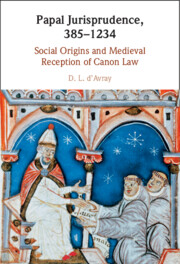Book contents
- Papal Jurisprudence, 385–1234
- Papal Jurisprudence, 385–1234
- Copyright page
- Dedication
- Contents
- Acknowledgements
- Abbreviations
- Sigla
- Introduction
- 1 Transformations and Long-Term Explanations
- 2 The Christian Roman Empire, c. 400
- 3 c. 400: Practical Complexities and Uncertainties
- 4 c. 400: Uncertainty about Grace
- 5 Papal Rulings and Ritual
- 6 Hierarchies
- 7 Clerical Status and Monks
- 8 Returning Heretics
- 9 Pelagianism and the Papacy
- 10 Leo I
- 11 Post-Imperial Syntheses
- 12 Early Papal Laws in the Barbarian West
- 13 Carolingian Culture and Its Legacy
- 14 1050–1150
- 15 Theology and Law
- 16 c. 400 and c. 1200: Complexity, Conversion, and Bigamia
- 17 Clerics in Minor Orders
- 18 Choosing Bishops
- Overall Conclusions
- Book part
- Select Bibliography
- Index
18 - Choosing Bishops
Published online by Cambridge University Press: 10 March 2022
- Papal Jurisprudence, 385–1234
- Papal Jurisprudence, 385–1234
- Copyright page
- Dedication
- Contents
- Acknowledgements
- Abbreviations
- Sigla
- Introduction
- 1 Transformations and Long-Term Explanations
- 2 The Christian Roman Empire, c. 400
- 3 c. 400: Practical Complexities and Uncertainties
- 4 c. 400: Uncertainty about Grace
- 5 Papal Rulings and Ritual
- 6 Hierarchies
- 7 Clerical Status and Monks
- 8 Returning Heretics
- 9 Pelagianism and the Papacy
- 10 Leo I
- 11 Post-Imperial Syntheses
- 12 Early Papal Laws in the Barbarian West
- 13 Carolingian Culture and Its Legacy
- 14 1050–1150
- 15 Theology and Law
- 16 c. 400 and c. 1200: Complexity, Conversion, and Bigamia
- 17 Clerics in Minor Orders
- 18 Choosing Bishops
- Overall Conclusions
- Book part
- Select Bibliography
- Index
Summary
Episcopal elections furnish another example of the enlargement of legal meaning in the course of its application to new states of affairs. The conversation started by Celestine I in 428 when he sent Nullus invitis to Southern Gaul was continued with reference to situations and conditions different from those of the Roman Empire. Not in all respects. Just as monks from late Roman Lérins were leapfrogging over local clerics to bishoprics in Gaul, friars were being appointed as bishops in the thirteenth century. But clerical communities around late Roman bishops resembled neither the gamut of clergy spread over large thirteenth-century dioceses, nor the canons of thirteenth-century cathedrals. The slow transformation of the Western diocese and the Investiture Contest left a legacy of uncertainty about how to elect a bishop. In the thirteenth century, the efforts to create a transparently rational system for larger and more impersonal units were complicated both by uncertainties of the ‘greater and sounder part’ rule, and by the complexities of the concrete situations revealed by ‘modern’ rulings, from the second age of decretals, which glossators bring to bear on Celestine I’s decision.
Keywords
- Type
- Chapter
- Information
- Papal Jurisprudence, 385–1234Social Origins and Medieval Reception of Canon Law, pp. 228 - 238Publisher: Cambridge University PressPrint publication year: 2022



